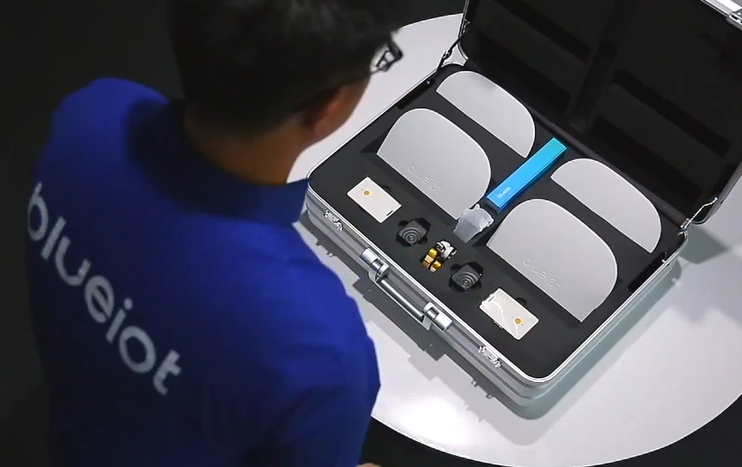With the rapid development of wireless technology, Bluetooth technology is widely used in various devices due to its low power consumption and simple connection characteristics. In recent years, the technical development of Bluetooth has also been continuously improved, among which Bluetooth AOA (Angle of Arrival) technology has become an important breakthrough in the field of positioning and navigation. This article will explore in depth the working principle, application scenarios and how to implement this technology in practice.

Basic principles of Bluetooth AOA technology
Bluetooth AOA is a positioning technology based on the angle of arrival of wireless signals. It determines the location of the transmitter by analyzing the angle at which the signal arrives at different receiving points. Unlike traditional distance-based positioning technologies (such as Bluetooth RSSI technology), AOA positioning focuses more on obtaining the relative position of the device through angles. This technology uses multiple receiving antennas to obtain different directions of signal arrival, combined with the principle of triangulation, to accurately calculate the spatial position of the target device.
Specifically, Bluetooth AOA technology usually requires at least two antennas to receive Bluetooth signals, and these antennas will measure the angle information of signal arrival respectively. Through these angle information, the system can calculate the location coordinates of the device, which can be further applied to indoor positioning, navigation, intelligent control and other scenarios.
Bluetooth AOA workflow
The Bluetooth AOA workflow can be simply divided into the following steps:
Signal transmission: The target device transmits data through Bluetooth wireless signals, which carry the device's identity information and other relevant data.
Signal reception: The receiving device (such as a Bluetooth base station or positioning receiver) is equipped with multiple antennas to receive the Bluetooth signal transmitted by the target device. Each antenna receives the signal at a slightly different angle.
Angle calculation: The receiving device uses the signal information received by multiple antennas to calculate the angle of signal arrival. By measuring the direction of signal arrival, the system can determine the approximate direction of the target device.
Position estimation: With the help of triangulation or more advanced algorithms, the receiving device can combine the angle information of multiple receiving points to deduce the precise location of the target device.
Advantages of Bluetooth AOA technology
High-precision positioning: Bluetooth AOA technology can provide more accurate positioning results than traditional RSSI (received signal strength indication) positioning technology. Since AOA mainly relies on the angle of signal arrival rather than signal strength, the direction and position of the target device can be determined more accurately.
Low power consumption: Bluetooth AOA still maintains the low power consumption characteristics of Bluetooth technology, which is suitable for devices that need to run for a long time, especially in the field of Internet of Things (IoT) and smart hardware.
Indoor positioning application: Traditional GPS positioning cannot work effectively in indoor environments, while Bluetooth AOA technology can overcome this limitation and is widely used in precise positioning of indoor places such as large shopping malls, museums, warehouses, etc.
Multifunctional integration: Bluetooth AOA technology can not only provide positioning services, but also interact with other smart devices to promote the rapid development of smart homes, automated offices and other fields.
Application scenarios of Bluetooth AOA
Bluetooth AOA technology is widely used in various fields, especially in indoor positioning and intelligent control.
Smart retail: Shopping malls can use Bluetooth AOA technology to accurately locate customers, provide customers with personalized shopping recommendations, and even automatically push discount information.
Indoor navigation: In large buildings, such as hospitals, exhibition halls, airports, etc., Bluetooth AOA can provide users with accurate indoor navigation services to help people find their destination quickly.
Smart home: Bluetooth AOA technology can help smart home devices identify the user's precise location and realize automatic operations such as smart lighting, temperature control, and security.
Asset tracking: Bluetooth AOA technology is also suitable for asset management and item tracking. In warehouses, logistics centers and other places, the status and location of goods can be monitored in real time through precise positioning.
How to implement Bluetooth AOA technology?
To implement Bluetooth AOA technology, the following hardware and software support is usually required:
Multi-antenna receiver: Receivers that support Bluetooth AOA technology must be equipped with multiple antennas so that they can accurately receive signals from different directions.
Bluetooth 5.1 and above: Bluetooth AOA technology requires Bluetooth 5.1 or higher Bluetooth standards, which support directional positioning functions.
Positioning algorithm: The corresponding positioning algorithm needs to be developed to process the angle data of the signal and calculate the location of the device. Common algorithms include triangulation, Kalman filtering, etc.
Application layer software: At the application layer, applications that adapt to Bluetooth AOA need to be designed to provide positioning data to users and complete functions such as indoor navigation or item tracking.
The introduction of Bluetooth AOA technology has undoubtedly brought new breakthroughs to wireless positioning technology. With its high precision and low power consumption, Bluetooth AOA technology has shown great application prospects in many fields such as indoor positioning and intelligent control. As the technology continues to mature, Bluetooth AOA will play an important role in more scenarios in the future and promote the development of smart life.